
Chapter 6.
Print Gap Control
73
If manual is selected, print gap detection will only be preformed when commanded by selecting
the detect parameter from the control panel.
Manual mode allows the “power” user to use the +
and
–
adjust keys to go directly to the gap of their choosing without having to run a print gap
detect operation. This mode, however, will allow the user to select print gaps which give very
poor print quality and shuttle, ribbon and or paper motion faults.
Each time the platen is commanded to close, it will go to the last value stored in the current
configuration. If the platen is commanded to close on an area of a form that is greater than the
current gap setting (such as a male perforation or label), a simplified auto detection will be
preformed and a new optimal gap setting saved. This may result in a few smudged print lines, as
the correction will be occurring after the printing has started
If no value has been stored in the current configuration the platen will drive to a value of 190. The
default value of the print gap in all the configurations will be set to 255 (0xFF). Since the
allowable print gap values are 0 to 190, 255 is used as a no print detect preformed flag. If the
platen is commanded to close and the current configuration has a value of 255, the platen will
close to a value of 190 and have an adjustment range of
–
190 / +0. This is similar to the reset
condition.
6.2.1.2
Detect Distance
This parameter is only meaningful if the detect mode is auto.
The options within this parameter are 0” to the current form length with increm
ents of a tenth of
an inch. The default setting is 2.0”. When a TOF key is pressed after a paper
-out error, this sets
the vertical distance from the top of form to where the print gap detect is preformed.
If a form is not of uniform thickness, detect distance allows the user to select where on the form to
detect the optimal print gap. Typically this would be the thickest part of the form. Since a print
gap detect has the side effect of placing dots on the form, this parameter also allows the user to put
these dots in a part of the form that does not affect readability. Even though this parameter allows
the gap detect to be performed on the perforation of the form (distance of 0” or the form length),
this is not recommended. The perforation thickness is not representative of the actual form
thickness and may give a sub-optimal print gap setting
6.2.1.3
Detect
When the enter key is pressed, the platen closes down at the current location until the form
compression point is reached. Based upon this compression point, a resulting optimal print gap
setting is computed and stored in the current configuration. Unlike the print gap detections that are
run after paper-out errors, this operation does not compare its calculated gap with the current
setting. It will just overwrite the current setting with the new one. The platen then returns to the
fully open position.
Содержание 6300 Series
Страница 1: ......
Страница 2: ...6300 Series Maintenance Manual Copyright 2004 Part Number 1189 093057 Revision D 11 04 TallyGenicom LP...
Страница 24: ...6300 Series Maintenance Manual 18...
Страница 54: ...6300 Series Maintenance Manual 48...
Страница 83: ...Appendix A Drawings 77 Appendix A Drawings 6306 Drawings...
Страница 110: ......
Страница 111: ......
Страница 112: ......
Страница 115: ......
Страница 120: ......
Страница 121: ......
Страница 122: ......
Страница 123: ......
Страница 124: ......
Страница 125: ......
Страница 126: ......
Страница 127: ......
Страница 128: ...6300 Series Maintenance Manual 78 6312 Drawings...
Страница 155: ......
Страница 156: ......
Страница 157: ......
Страница 158: ......
Страница 161: ......
Страница 167: ......
Страница 168: ......
Страница 169: ......
Страница 170: ......
Страница 171: ......
Страница 172: ......
Страница 173: ......
Страница 174: ......
Страница 175: ......
















































